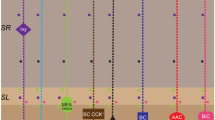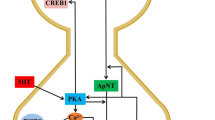Abstract
The electrosensory lateral line lobe (ELL) of mormyrid electric fish is a cerebellum-like structure that receives primary afferent input from electroreceptors in the skin. Purkinje-like cells in ELL store and retrieve a temporally precise negative image of prior sensory input. The stored image is derived from the association of centrally originating predictive signals with peripherally originating sensory input. The predictive signals are probably conveyed by parallel fibers. Recent in vitro experiments have demonstrated that pairing parallel fiber-evoked excitatory postsynaptic potentials (epsps) with postsynaptic spikes in Purkinje-like cells depresses the strength of these synapses. The depression has a tight dependence on the temporal order of pre- and postsynaptic events. The postsynaptic spike must follow the onset of the epsp within a window of about 60 msec for the depression to occur and pairings at other delays yield a nonassociative enhancement of the epsp. Mathematical analyses and computer simulations are used here to test the hypothesis that synaptic plasticity of the type established in vitro could be responsible for the storage of temporal patterns that is observed in vivo. This hypothesis is confirmed. The temporally asymmetric learning rule established in vitro results in the storage of activity patterns as observed in vivo and does so with significantly greater fidelity than other types of learning rules. The results demonstrate the importance of precise timing in pre- and postsynaptic activity for accurate storage of temporal information.
Similar content being viewed by others
References
Abbott LF, Blum KI (1996) Functional significance of long-term potentiation for sequence learning and prediction. Cerebral Cortex 6:406-416.
Bastian J (1995) Pyramidal-cell plasticity in weakly electric fish: A mechanism for attenuating responses to reafferent electrosensory inputs. J. Comp. Physiol. A 176:63-73.
Bell CC (1982) Properties of a modifiable efference copy in an electric fish. J. Neurophysiol. 47:1043-1056.
Bell CC, Bodznick D, Montgomery J, Bastian J (1997a) The generation and subtraction of sensory expectations within cerebellum-like structures. Brain. Beh. Evol. 50:17-31 (suppl. 1).
Bell CC, Caputi A, Grant K, Serrier J (1993) Storage of a sensory pattern by anti-Hebbian synaptic plasticity in an electric fish. Proc. Natl. Acad. Sci. USA 90:4650-4654.
Bell CC, Grant K, Serrier J (1992) Sensory processing and corollary discharge effects in the mormyromast regions of the mormyrid electrosensory lobe: I. Field potentials and cellular activity in associated structures. J. Neurophysiol. 68:843-858.
Bell CC, Han V, Sugawara Y, Grant K (1997b) Synaptic plasticity in a cerebellum-like structure depends on temporal order. Nature 387:278-281.
Bell CC, Szabo T (1986) Electroreception in mormyrid fish: Central anatomy. In Bullock TH, Heiligenberg W, eds. Electroreception. Wiley, New York. pp. 375-421.
Bi Q, ming Poo M (1998) Precise spike timing determines the direction and extent of synaptic modifications in cultured hippocampal neurons. J. Neurosci. 18:10464-10472.
Binder K (1979) Introduction: Theory and "technical" aspects of Monte Carlo simulations. In Binder K, ed. Monte Carlo Methods in Statistical Physics. Springer-Verlag, Berlin. pp. 1-45.
Bodznick D, Montgomery JC, Bradley DJ (1992) Suppression of common mode signals within the electrosensory system of the little skate Raja erinacea. J. Exp. Biol. 171:107-125.
Chauvet GA (1993) An n-level field theory of biological neural networks. J. Math. Biol. 31:771-795.
Gerstner W, Kempter R, van Hemmen JL, Wagner H (1996) A neuronal learning rule for sub-millisecond temporal coding. Nature 383:76-78.
Gerstner W, Ritz R, van Hemmen JL (1993) Why spikes? Hebbian learning and retrieval of time-resolved excitation patterns. Biol. Cybern. 69:503-515.
Gerstner W, van Hemmen JL (1992) Associative memory in a network of "spiking" neurons. Network 3:139-164.
Grant K, Sugawara Y, Gomes L, Han V, Bell CC (1998) The Mormyrid electrosensory lobe in vitro: Physiology and pharmacology of cells and circuits. J. Neurosci. 18:6009-6025.
Han V, Bell CC, Grant K, Sugawara Y (1999) Mormyrid electrosensory lobe in vitro: I. Morphology of cells and circuits. J. Comp. Neurol. 404:359-374.
Kempter R, Gerstner W, van Hemmen JL (1999) Symbols, neurons, soap-bubbles and the neural computation underlying cognition. Physical Review E 59:4498-4514.
Levy WB, Steward O (1983) Temporal contiguity requirements for long-term associative potentiation/depression in the hippocampus. Neurosci. 8:791-797.
Markram H, Lübke J, Frotscher M, Sakmann B (1997) Regulation of synaptic efficacy by coincidence of postsynaptic APs and EPSPs. Science 275:213-215.
Nelson ME, Paulin MG (1995) Neural simulations of adaptive reafference suppression in the elasmobranch electrosensory system. J. Comp. Physiol. A 177:723-736.
Roberts PD (1999a) Computational consequences of temporally asymmetric learning rules: I. Differential Hebbian learning. J. Compu. Neurosci. 7:235-246.
Roberts PD (1999b) Dynamics of temporal learning rules (submitted).
Sejnowski TJ (1977) Statistical constraints on synaptic plasticity. J. Theor. Biol. 69:385-389.
Zhang LI, Tao HW, Holt CE, Harris WA, ming Poo M (1998) A critical window for cooperation and competition among developing retinotectal synapses. Nature 395:037.
Author information
Authors and Affiliations
Rights and permissions
About this article
Cite this article
Roberts, P.D., Bell, C.C. Computational Consequences of Temporally Asymmetric Learning Rules: II. Sensory Image Cancellation. J Comput Neurosci 9, 67–83 (2000). https://doi.org/10.1023/A:1008938428112
Issue Date:
DOI: https://doi.org/10.1023/A:1008938428112




